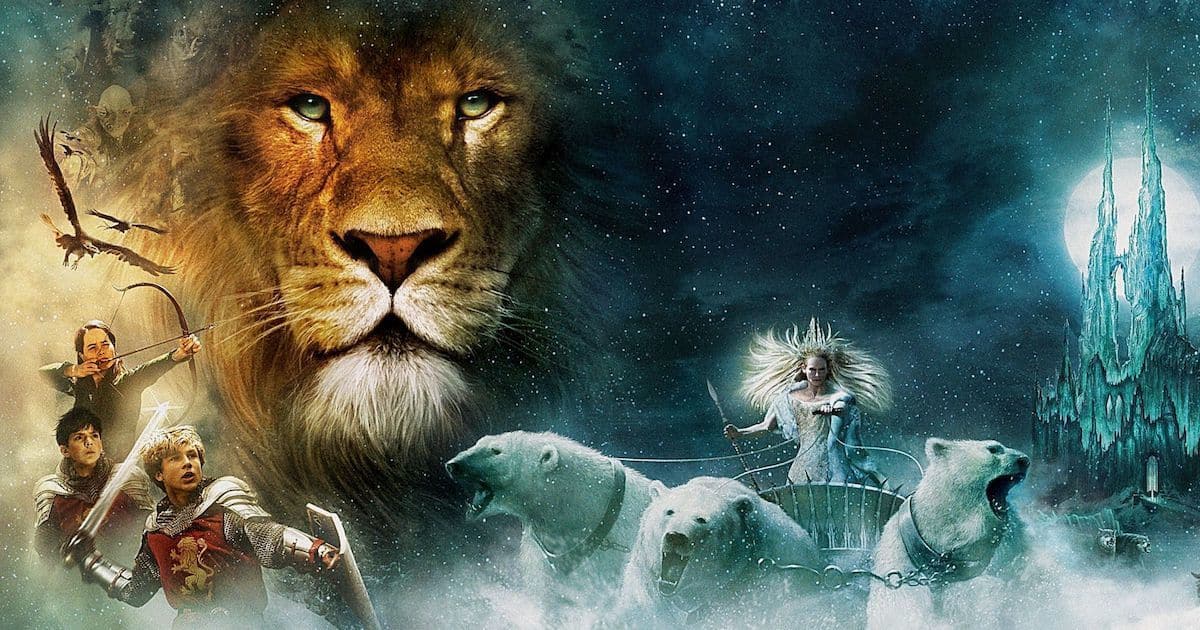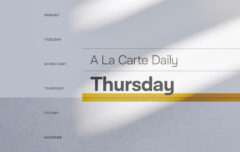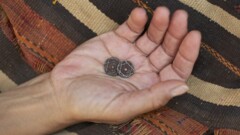It’s hardly theological novelty or historical oddity to suggest we should be wary of presenting the immaterial God in physical form. This was the point of my recent article on The Shack movie in which I expressed my concern that its portrayal of God the Father and God the Holy Spirit is a violation of the second commandment. I was surprised by the scope and tone of the response. Yet amid many retorts and accusations, I received one thoughtful question from at least a hundred people: What about Narnia? If it is wrong to portray God the Father as the human Papa, isn’t it equally wrong to portray God the Son as the lion Aslan?
This is a very good question and I am glad to answer it. In what follows I want to tell why Papa of The Shack is not Aslan of Narnia. I will argue they are not the same in three key ways: they are from different genres of literature, portray different characters, and teach different messages.
Different Genres
The first key difference between The Shack and Narnia is one of genre. What genre is C.S. Lewis’s Narnia series? I would argue that it is allegorical fiction, but not full-out allegory. According to The Oxford Dictionary of Literary Terms, an allegory is “a story or visual image with a second distinct meaning partially hidden behind its literal or visible meaning.” Further, allegory “involves a continuous parallel between two (or more) levels of meaning in a story, so that its persons and events correspond to their equivalents in a system of ideas or a chain of events external to the tale.” Discussions and definitions of the term invariably point to The Pilgrim’s Progress as the most notable English-language example. Bunyan’s tale is an allegory because every major character, setting, and plot twist closely corresponds with a Christian idea or doctrine. The main character represents believers, his pilgrimage represents the Christian life, his burden represents sin, and so on. The key to allegory is the intentional, ongoing, and substantial parallel between the fictional world and the real world.
The Narnia books are not fully allegorical because they do not involve a continuous and substantial parallel between Narnia’s world and our own, or between the mythology of Narnia and the tenets of Christianity. But they undoubtedly do involve a general parallel, so that the perpetual winter of Narnia corresponds in some details to humanity’s state of sinfulness while the White Witch corresponds in some details to the devil. Yet there are many other elements of this universe that have no identifiable parallel. It would be a wrong reading of Narnia to assign great significance to the lamppost, the fawn, or other incidental characters and details.
A right reading of Narnia does not lead to the declaration, “Aslan is Jesus,” but the realization, “Aslan is like Jesus.”
Here is how Lewis explained his most memorable creation, the lion Aslan: “[Aslan] is an invention giving an imaginary answer to the question, ‘What might Christ become like, if there really were a world like Narnia and He chose to be incarnate and die and rise again in that world as He actually has done in ours?’” Aslan is a Christ-like figure, but is not Christ. We should expect to find a general but not perfect correspondence between the words and deeds of Aslan and the words and deeds of Jesus Christ. A right reading of Narnia does not lead to the declaration, “Aslan is Jesus,” but the realization, “Aslan is like Jesus.” Lewis meant for Aslan to evoke a kind of wonder that would cause the reader to search for someone in the real world who is equally awe-inspiring.
What genre is The Shack? Some describe it as allegory, but according to established definitions, this is not the correct genre. It does not have “a second distinct meaning partially hidden behind its literal or visible meaning.” Neither does it feature a “continuous parallel between two (or more) levels of meaning” in its story. Mack does not stand in for all of humanity and the cabin does not represent a universal spiritual epiphany. It does not veil its plain meaning behind a figurative one. Young himself denies his work is an allegory.
So what is The Shack? I believe it is best described as didactic fiction. Didactive works are “designed to impart information, advice, or some doctrine of morality or philosophy.” This descriptor fits because The Shack is a story meant to teach doctrinal or theological truth. It is not a story that stands on its own, but a story that exists to teach. Through the narrative, the reader comes to learn about the nature and works of God. Young means to impart new information and correct false information, and ultimately, to have the reader realize with Mack, “I [God] am not who you think I am.” In this way, The Shack is a distinctly theological novel in the same genre as Brian McLaren’s A New Kind of Christian or Trevin Wax’s Clear Winter Nights.
Thus, Narnia is allegorical fiction that engages select tenets of the Christian faith through their analogs in a fantastical world. This created world has a similar but not identical religious system and its story is told through similar but not fully-corresponding characters. The Shack is didactic fiction that engages select tenets of the Christian faith in a realistic world through characters meant to accurately represent divine persons described in the Bible.
Different Persons
We have established, then, that these books are different genres. Now, who do our two characters represent? According to Lewis, Aslan represents a Christ-like figure as he might exist in a parallel universe. To my knowledge, Narnia has no doctrine of the Trinity, but we do hear of Aslan’s father, a character known as the Emperor-Beyond-The-Sea. He is ruler of the universe and the one responsible for the Deep Magic, the system of laws or religion that governs their world. This character exists, but is never seen or described. Thus, Lewis gives form only to his equivalent of God the Son.
Any image of God is misleading. Any image of God lies more than it teaches the truth.
In The Shack we see all three members of the Godhead taking on form—God the Father as Papa, God the Son as Jesus, and God the Holy Spirit as Sarayu. In the film, all three roles are depicted by human actors. In this way, Young gives form to God the Son who actually took form, but also to the immaterial Father and Holy Spirit who did not and will not take form. Giving form to the immaterial is the very transgression forbidden in the second commandment. The second commandment does not forbid making images of God only if we actually attach divinity to them. The Israelites bowing down before that golden calf knew Yahweh wasn’t gold and wasn’t a cow, but thought that a visible representation would help them think better about God and better focus their thoughts on him. The concern of the second commandment is that by portraying God in any way we diminish God. Any image of God is misleading. Any image of God lies more than it teaches the truth. As Neil Postman says in Amusing Ourselves to Death, “The God of the Jews was to exist in the Word and through the Word, an unprecedented conception requiring the highest order of abstract thinking. Iconography thus became blasphemy so that a new kind of God could enter a culture. People like ourselves who are in the process of converting their culture from word-centered to image-centered might profit by reflecting on this Mosaic injunction.”
Here, then, is a key difference between Narnia and The Shack. Aslan is a character from a different world and a different system of beliefs who has some similarities to God the Son. The Shack presents a character in this world who claims to be God the Son. It also presents characters in this world who claim to be God the Father and God the Holy Spirit. To look at Aslan on the silver screen is to see a character who is like Jesus in some key ways; to look at Papa or Sarayu on the silver screen is to see characters who claim “I am God the Father” and “I am God the Holy Spirit.” (Let me say this clearly: My concern with portraying God the Father as Papa and God the Spirit as Sarayu has nothing to do with their race or gender, or even their humanity. The concern is portraying God as anything at all.)
Aslan faithfully represents Christ without claiming to be him; Papa claims to be God without accurately resembling him.
If Aslan was portrayed in Narnia as a human figure, it would be no violation of the second commandment (even if it would wreck the story). If Papa was portrayed in The Shack as a lion, it would be a violation of the second commandment. Aslan faithfully represents Christ without claiming to be him; Papa claims to be God without accurately resembling him.
Different Messages
Narnia and The Shack are different genres of literature and incarnate different characters. The third key difference is in the messages those characters teach.
Through the Narnia books, Aslan acts and speaks in ways that explain the mythological system that exists only within Lewis’s fantasy world. As Aslan does these things, he generally evokes the actions and deeds of his real-world counterpart, Jesus. Yet because the tale is allegorical, he does so incompletely so that much of what he does and says has no meaning beyond the story.
Papa, Jesus, and Sarayu of The Shack represent or, indeed, are, God the Father, God the Son, and God the Holy Spirit of this world and of the Christian faith. All they say and teach is meant to be taken as an accurate representation of what God has done and what his Word teaches in this world. They do not perform actions in a parallel world, but in this one. They do not teach a mythological religion, but the Christian religion. There is no second level to the tale, no allegory to interpret or parable to unravel. The words Young puts in the mouth of Papa are words meant to describe God himself. Similarly, the actions performed at the hand of Sarayu are actions meant to describe how the Holy Spirit truly behaves.
To portray Aslan the lion is not to portray Jesus Christ. It is, at most, to portray a Christ-like figure.
To portray Aslan the lion is not to portray Jesus Christ. It is, at most, to portray a Christ-like figure. The fabricated mythology of Narnia reminds us of the true myth of the real world, but does not fully represent it. By observing Aslan and considering his words we might gain some hints about what Christ is like and what he has done, and Lewis meant for these hints or prompts to drive us to deeper exploration of our own world and its true faith. Fictional Aslan should prompt us to explore factual Christ—the Christ of the traditional Christian faith that Lewis had come to discover as an adult and for which he became such a beloved spokesman.
To portray Papa the human is to portray a figure who is meant to directly represent God the Father. The doctrine of The Shack is meant to exactly correspond to the doctrine of the real world. Papa of The Shack, at least in her personality, her characteristics, her deeds, and her doctrine, is meant to be the God of the real world. She speaks on behalf of God the Father. It is only her form and the necessary elements of the story that we are to take as fictional. She is an identifiable real-world character who is anthropomorphized and inserted into a fictional tale. Yet, as so many have documented, the Godhead of The Shack teach messages that are inconsistent with the historic Christian faith and that subvert the message of the Bible. This is not the place to exhaustively describe those doctrinal concerns and, thankfully, many have already done so.
Where in Narnia the reader is meant to look at Aslan and say, “Aslan is like Jesus,” there is a much greater degree to which the reader of The Shack is meant to look at Papa and say, “Papa is God.” Where Aslan is meant to speak generally of a Christ-like figure, Papa is meant to speak specifically about who God is and what God has done. For this reason, we are right to expect more of Papa than Aslan. We are right to expect that Papa will accurately represent God in his person, his works, and his words. Yet where Aslan performs his function well, Papa performs her function woefully.
Papa ≠ Aslan
I have argued on three grounds that Papa of The Shack is not Aslan of Narnia. They appear in different genres of literature, represent different characters, and teach different messages. Narnia is an allegorical tale; The Shack is didactic fiction. Aslan is a Christ-like figure from a parallel world and its fabricated mythology; Papa is God the Father in the real-world and its Christian faith. What Narnia teaches by analog is generally consistent with the historic Christian faith and meant to create confidence in it; what The Shack teaches using literal characterization is subversive of the Christian faith and meant to undermine it. My counsel, then, is to enter Narnia but stay out of The Shack.










